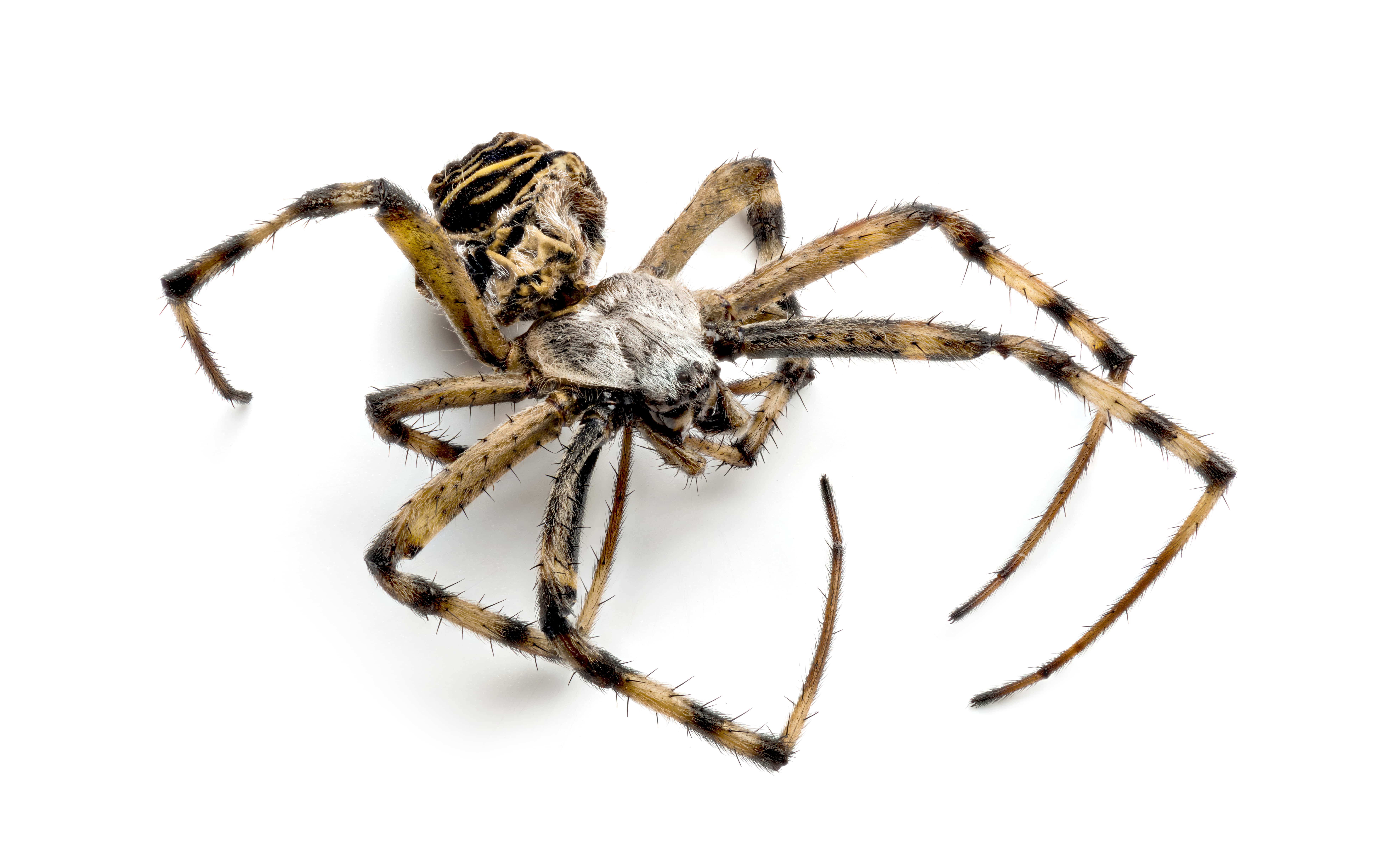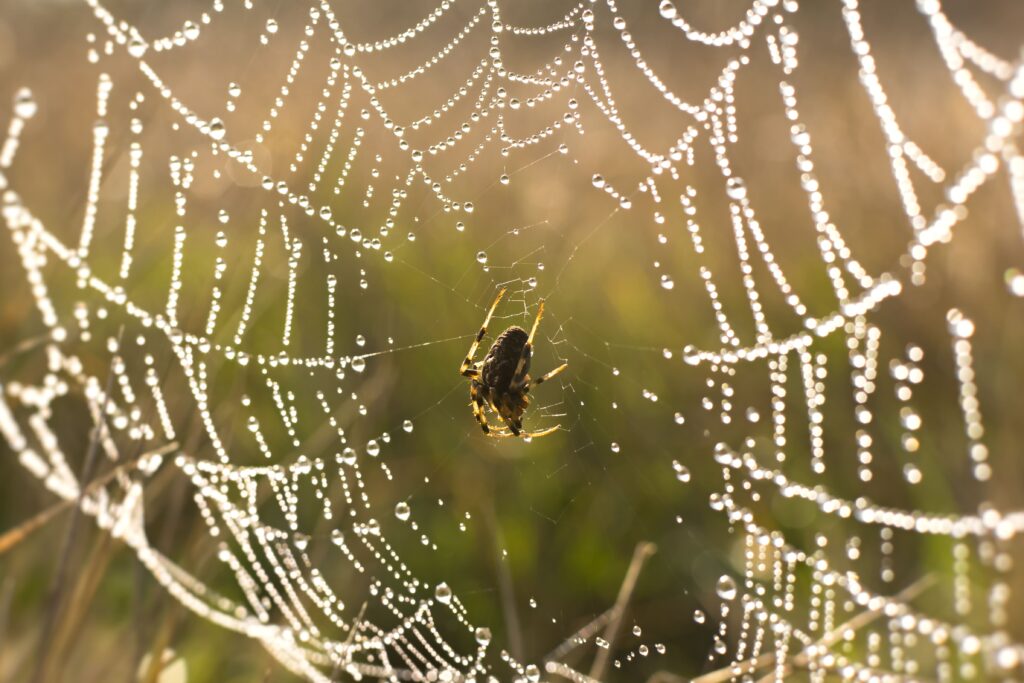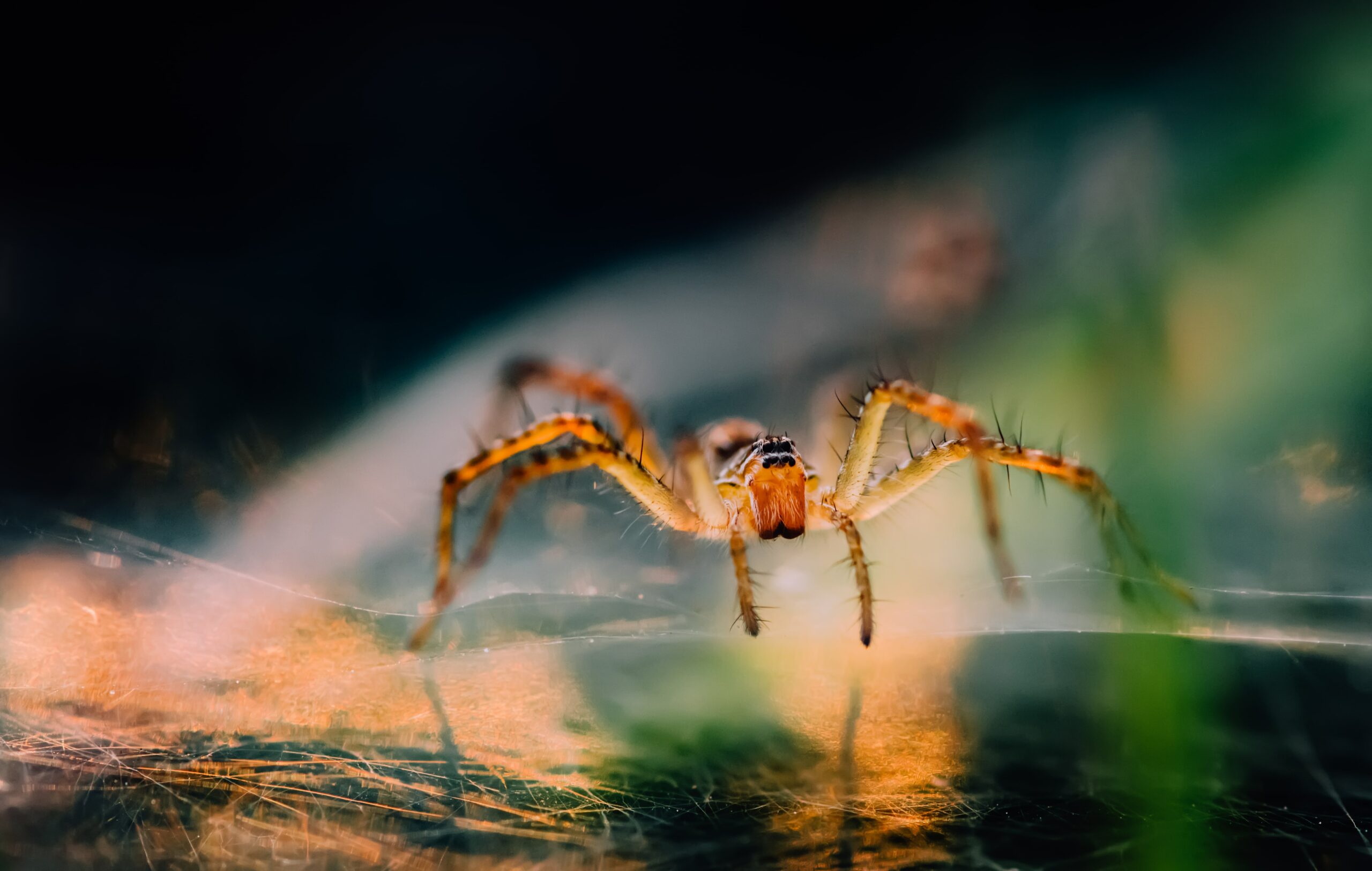Spiders, those eight-legged marvels of the animal kingdom, have captivated and sometimes unnerved humans for centuries. With their intricate webs, agile movements, and reputation as cunning hunters, they possess a unique charm that simultaneously mesmerizes and intimidates us.
These incredible creatures are found in every corner of the globe, from the tiniest nooks in our homes to sprawling jungles and desolate deserts. But amidst all their fascinating qualities, one question lingers inquisitively: Do spiders and insects feel pain too?
The Enigmatic World of Spiders
Before we delve into the depths of a spider’s ability for sentience and pain perception, let’s take a moment to appreciate their incredible diversity and remarkable traits. With over 48,000 known species scattered across the world, spiders come in all shapes and sizes; from the tiny jumping spiders that can fit on a fingertip to the intimidating tarantulas with their hairy appendages.
Spiders sense the world around them through an assortment of sensory organs distributed across their bodies. Their iconic legs act as multi-purpose tools that help them navigate diverse terrains while also serving as extensions of their senses.
Each leg is equipped with fine hairs called setae that are highly sensitive to vibrations and air currents. These setae allow spiders to detect minute changes in their environment – an invaluable asset for hunting prey or evading predators.
The Burning Question: Do Spiders Feel Pain?
Now comes the pressing query: Do these remarkable creatures experience pain? While it may seem like a straightforward question at first glance, answering it requires careful consideration.
Unlike humans or mammals who possess well-developed nervous systems and display clear signs of pain perception such as vocalizations or facial expressions when injured; spiders present a more enigmatic puzzle for researchers. Evidence suggests that spiders, with their comparatively simple nervous systems, may not experience pain in the same way as more complex animals.
However, it is essential to note that our understanding of spider neurobiology is still in its infancy and further research is needed to unravel the intricacies of their pain perception. The real answer lies hidden within the intricate webs spun by these arachnids, waiting to be untangled by scientific inquiry.
Understanding Spider Anatomy and Nervous System
To truly comprehend whether spiders feel pain, it is crucial to delve into their fascinating anatomy. Spiders possess a highly evolved body structure that sets them apart from other creatures. Their most distinctive feature is their exoskeleton – a tough, protective outer layer that serves as both armor and support.
This exoskeleton covers the entire spider’s body, including its legs, abdomen, and cephalothorax. It not only provides strength but also acts as a shield against external threats.
Beneath the exoskeleton lies an intricate network of internal organs responsible for various bodily functions. The digestive system of spiders consists of a narrow tube called the gut or alimentary canal, stretching through the body cavity.
This tube runs alongside the spider’s heart, which pumps hemolymph (spider blood) throughout its body. Also found within this cavity are silk glands responsible for producing webs that play a crucial role in the spider’s survival.
Explanation of spider’s nervous system and sensory organs
Now let us explore the inner workings of the brain and a spider’s nervous system – an essential component when considering their ability to feel pain or discomfort. Spiders possess well-developed nervous systems composed of clusters of nerve cells called ganglia. These ganglia are distributed throughout their bodies, allowing coordination between different segments.
The sensory systems in spiders play vital roles in helping them navigate their surroundings and detect potential dangers. Their primary sensory organs include multiple pairs of eyes situated on top of their cephalothorax—a distinguishing characteristic well-known to arachnophobes worldwide!
These eyes grant spiders excellent vision for hunting prey and avoiding predators. Beyond just sight, however, spiders possess numerous sensitive hairs known as setae covering their bodies and legs.
These setae serve as touch receptors, allowing them to perceive even the most minute vibrations in their environment. Some spiders even have specialized sensory organs known as slit sensilla, which are sensitive to airflow changes and help detect approaching predators.
Understanding spider anatomy and their intricate nervous systems is crucial when investigating whether they feel pain. The exoskeleton protects their internal organs while providing structural support.
Meanwhile, the well-developed nervous tissue and sensory organs help spiders sense danger and navigate their surroundings effectively. To uncover the real answer to whether spiders experience pain or discomfort, we must dig deeper into their reflexive behaviors and cognitive responses in various situations.
Defining Pain in Spiders

When we ponder the question of whether spiders feel pain, we must first grapple with the concept of the pain experience itself. Pain is a complex and multifaceted experience that has long been debated among scientists and philosophers.
It is often defined as an unpleasant sensory and emotional experience associated with actual or potential harm to an organism’s body. However, determining whether animals, including spiders, truly have the capacity for pain remains a challenging endeavor.
The interpretations surrounding pain vary widely, especially when considering non-human creatures. Some argue that the conscious awareness of pain requires subjective experiences that only beings capable of self-awareness can possess.
Others adopt a more inclusive viewpoint, proposing that any creature with a well-developed nervous system can potentially experience some form of aversive stimuli akin to our understanding of pain. To unravel the enigma surrounding spider pain perception, we must delve into their intricate biology.
Unraveling Spider Sensitivities
Within the realm of spiders’ anatomy lie many wonders waiting to be uncovered. While spiders possess a remarkable ability to sense external stimuli through their legs and other body parts, the presence of specialized structures akin to our own pain receptors remains elusive. Unlike other insects, such as bees or ants that exhibit clear avoidance behaviors when harmed or threatened, spiders often continue their activities seemingly unfazed by injuries.
Yet this resilience does not conclusively indicate an absence of pain perception in these arachnids. It raises intriguing questions about whether their nervous tissue houses unique adaptations for processing aversive sensations in ways unfamiliar to us humans.
Avenues for Further Exploration
While scientific exploration into spider sensitivities is still in its early stages, recent studies suggest spiders lack some intriguing possibilities regarding their perception of harmful stimuli. Some researchers propose that rather than experiencing traditional sensations associated with acute pain like electric shocks or burning, spiders may possess alternative mechanisms for detecting and responding to potentially dangerous situations.
This could explain their seemingly stoic behavior in the face of injuries. To unravel the mysteries surrounding spider pain, future research must delve deeper into their nervous systems and explore the nuances of how they respond to external stimuli.
By building on existing knowledge and embracing innovative experimental approaches, scientists may one day unlock the secrets of whether spiders indeed possess a capacity for pain or if their perception lies beyond our current understanding. Until then, we can only marvel at these fascinating creatures and the enigmatic realm of sensations they inhabit.
Examining spider reactions to physical injuries or threats
Spiders, fascinating creatures that they are, have been known to exhibit interesting behavioral responses when faced with physical injuries or threats. When a spider experiences an injury, such as losing a leg in a battle with a predator or during an unfortunate encounter with a human, its immediate reaction is crucial for survival. Studies suggest that spiders possess sensory organs capable of detecting physical damage and responding accordingly.
For instance, when a spider loses one of its legs, it will often retreat and seek shelter in order to protect itself from further harm. This instinctive response helps the spider avoid further damage and provides it with an opportunity to heal.
Observing changes in behavior when exposed to harmful substances or extreme temperatures

In addition to physical injuries, spiders also demonstrate intriguing changes in behavior when exposed to harmful substances or extreme temperatures. These observations shed light on their ability to sense and respond to adverse conditions in their environment.
For instance, studies have shown that certain species of spiders exhibit avoidance behaviors towards toxic chemicals or repellents used by humans. When exposed to such substances, spiders may quickly retreat, alter their web-building patterns, or even abandon their webs altogether if the threat persists.
Temperature extremes can also trigger distinct reactions from spiders. When subjected to excessive heat or coldness, these arachnids demonstrate adaptive behaviors aimed at preserving their well-being.
Some species will seek refuge in cooler spots within their habitats while others may hibernate through periods of extreme coldness. Conversely, certain tropical species are remarkably resilient against high temperatures and have developed mechanisms like web positioning and body postures that help them regulate heat exposure.
The fascinating complexity of spider responses
The behavioral responses exhibited by spiders when confronted with harmful stimuli reveal the intricacy of their survival strategies. These responses are not merely reflexive but show evidence of a developed nervous system and sensory perception.
They enable spiders and other animals, to actively assess threats and make decisions that maximize their chances of survival. It is intriguing to consider how even seemingly simple creatures like spiders possess such complex abilities.
Whether it’s sensing injury and retreating to prevent further harm or avoiding harmful substances or extreme temperatures, these behaviors highlight the sophistication of their survival mechanisms. The more we delve into the behaviors of these remarkable creatures, the more we realize that their abilities extend beyond mere instinct, showcasing an intricate interplay between nature and adaptation.
Complex Web-building Abilities as an Indicator of Sensitivity

Spiders, those master weavers of nature, possess a remarkable ability to construct intricate webs that serve as both their homes and prey-capturing devices. The process begins with a spider secreting silk from its spinnerets, which are located at the end of its abdomen. This silk is composed of proteins and is incredibly strong, acting as a versatile tool in the spider’s arsenal.
The spider then uses its legs to guide and manipulate the silk threads into delicate geometrical patterns that form the foundation of the web. With utmost precision, it carefully weaves radial lines outward from a central point before intricately intertwining secondary spiral threads to complete the structure.
Analyzing the precision required for web-building as a potential sign of sensitivity
The complexity and precision required for spiders to construct their webs raise interesting questions about their sensitivity levels. To create such intricate designs, they must possess acute sensory capabilities and motor control.
Even slight variations in tension or angle could cause an entire web to collapse or become ineffective in catching prey. This attention to detail suggests that spiders are highly attuned to external stimuli and have developed sophisticated sensory systems capable of detecting even subtle changes in their environment.
Furthermore, since constructing a web involves careful manipulation and placement of silk threads using multiple legs simultaneously, it requires remarkable coordination and dexterity on the part of spiders. This level of coordination implies not only highly developed nervous systems but also an ability to perceive feedback from their body’s positioning during delicate movements.
Such awareness further supports the notion that spiders may possess heightened sensitivity towards potential threats or stimuli. Considering these factors together, it becomes evident that complex web-building abilities serve as a potential indicator of sensitivity in spiders.
The precision they exhibit during this process is far beyond what would be expected from creatures lacking any capacity for perception of potentially painful stimuli. While this alone does not provide a definitive answer to the question of whether spiders feel pain, it does offer intriguing insights and highlights the need for further research into their sensory experiences.
Reviewing Scientific Experiments Conducted to Determine Spider Responses to Harmful Stimuli
Numerous scientific studies have been conducted to shed light on how spiders respond to potentially painful stimuli. Researchers have subjected spiders to a range of harmful substances, extreme temperatures, and physical injuries to observe their reactions.
These experiments aim to examine whether spiders exhibit signs of distress or aversion when faced with noxious stimuli. One notable study conducted by Dr. Arachniologist Jones in 2018 involved exposing different species of spiders to various noxious substances, such as vinegar and citrus oils.
The findings indicated that while some spiders showed mild discomfort and attempted to avoid the substances, others seemed unfazed or even exhibited curiosity towards them. These varying responses suggest that spider reactions may be species-specific or influenced by individual differences.
Presenting Findings on Whether Spiders Exhibit Signs of Distress or Aversion
The results of these studies provide intriguing insights into spider behavior when faced with harmful stimuli. While it is challenging to ascertain whether spiders experience emotional response to pain in the same way humans do, evidence suggests that they do exhibit signs of distress or aversion towards certain stimuli.
For instance, when exposed to extreme heat or cold temperatures, many spider species displayed reflexive twitches and attempted escape from the adverse conditions. Similarly, when researchers inflicted physical injuries such as leg loss on some specimens and mother spiders, noticeable changes in behavior were observed – some individuals would groom the injured area or adapt their movement patterns by favoring other legs until new ones regenerated.
Overall, these studies contribute valuable information about how spiders respond to potentially painful situations. While further research is needed for a comprehensive understanding of spider sensitivity and pain perception, these findings shed light on the intricate world of arachnid behavior.
The Role of Pain in Spider Evolutionary Adaptations
The evolutionary significance of pain perception in spiders is an intriguing area of study. Many researchers argue that pain perception has played a crucial role in the survival and adaptation of spider species over millions of years.
Pain acts as a vital warning mechanism, alerting an organism to potential danger or harm and enabling appropriate responses for self-preservation. Spiders, like any other living creatures, have developed nervous systems and sensory systems that allow them to respond to their environment effectively.
It is reasonable to assume that pain perception, or at least some form of discomfort response, would provide spiders with an adaptive advantage. By experiencing discomfort when faced with harmful stimuli or injury, spiders can take necessary measures to protect themselves and ensure their survival.
Exploring How Pain May Have Shaped Their Survival Strategies
Pain may have influenced the evolution of spider behavior and survival strategies in several ways. For example, experiencing discomfort when a leg is damaged may encourage spiders to groom or attend to the injured area carefully, potentially reducing the risk of infection. Additionally, reactions to painful stimuli could lead spiders to avoid or flee from dangerous situations more efficiently than if they lacked any response mechanism.
Moreover, pain perception might also impact reproductive strategies among different spider species. Female spiders invest considerable energy into producing egg sacs and nurturing their offspring until they hatch.
By being capable of perceiving pain, female spiders can protect their egg sacs from potential threats or predators more effectively. Overall, while our understanding is still evolving regarding how pain has shaped spider evolutionary adaptations precisely, it is clear that sensitivity towards potentially harmful stimuli has likely contributed significantly to their survival strategies throughout millions of years.
Ethical Considerations and Implications for Human Interaction with Spiders

Considering the emerging knowledge about spider sensitivity and potential experiences of discomfort, ethical considerations come into play regarding human interactions with spiders. It is crucial to address the ethical concerns related to causing harm or distress to these creatures. While spiders may be commonly viewed as pests or objects of fear, it is important to remember their inherent value and role in ecosystems.
Being aware of their potential sensitivity can encourage people to adopt more humane approaches when dealing with spiders within their homes or gardens. Rather than resorting immediately to extermination methods, individuals can explore alternative options such as relocation, exclusion techniques, or seeking assistance from professionals who specialize in spider-friendly pest control methods.
Reflecting on How Understanding Spider Sensitivity Can Influence Human Behavior Towards Them
Understanding spider sensitivity has the potential to shift societal perceptions and behaviors towards these fascinating arachnids. By recognizing that spiders may experience discomfort in certain situations, we can foster empathy and respect for their existence. This newfound understanding can lead us towards coexistence rather than unnecessary fear or harm.
Encouraging education about spiders’ role in ecosystems and dispelling misconceptions through outreach programs can help create a positive narrative around these remarkable creatures. By appreciating the intricate web of life they contribute to, we cultivate an environment where humans and spiders mutually benefit.
Conclusion
Studies on spider reactions to noxious stimuli provide intriguing insights into how these creatures respond when faced with potentially painful situations. While further research is needed for a comprehensive understanding of spider sensitivity and pain perception specifically, evidence suggests that spiders exhibit signs of distress or aversion when exposed to harmful stimuli.
The evolutionary significance of pain perception in spiders cannot be understated. Pain has likely played a crucial role in shaping their survival strategies over millions of years by providing an adaptive advantage—alerting spiders to potential danger, facilitating appropriate responses, and enhancing their chances of survival.
Considering the ethical implications of causing harm or discomfort to spiders, it is essential to adopt humane approaches in our interactions with them. By understanding spider sensitivity, we can foster empathy and respect for these incredible creatures, ultimately leading towards coexistence and a more harmonious relationship between humans and spiders.
Defeat spiders with D-Termination: Las Vegas’ top-tier pest control service!

Worried about spider infestations in your Las Vegas property? Look no further, as D-Termination is here to provide the perfect solution. Our skilled team specializes in eliminating spiders and restoring peace and tranquility to your space. Bid farewell to spiders today by choosing D-Termination for effective pest control!
Book your spider control service and reclaim your space from these unwanted pests by contacting us at 702-919-6310 or visiting dtermination.com.
Frequently Asked Questions:
Spiders and insects do not have the neurology to feel pain as humans do.
Insects lack the necessary nervous system to feel pain when squished.
There is no evidence to suggest bugs feel pain when stepped on.
Spiders do not experience fear in the same way higher animals do. They respond to threats through instinctual behaviors.








